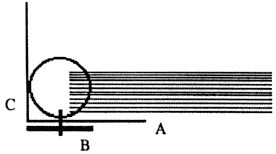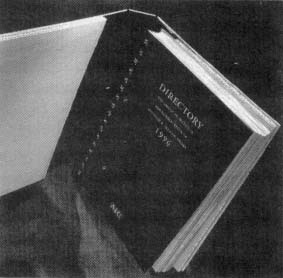

Books with plastic or metal spiral bindings can be a problem when they are shelved. The cover is usually not stiff enough to support the volume, and the spiral is normally wider than the text block, allowing the book to shift or stagger as it tries to stand on the shelf.
Many libraries have these books rebound to eliminate the problem. Various styles of binding can be used: fan-adhesive and oversewing are two popular methods. Unfortunately, some heavy or laminated papers do not function properly in these structures. The lack of a gutter margin is another problem. Yet another concern that might be overlooked is the original intent of the publisher. We are increasingly aware of the need to save original publisher's bindings produced around the turn of the century. Consideration should be given to some current spiral bindings that may be unique and should be saved.
My first involvement with this type of project started when a client had fifteen spiral binders that stood in disarray on the shelf. As an alternative to rebinding, I suggested an enclosure. A simple hard-cover, square-back case was made, and fillers of acid-free corrugated board were added to bulk out the text area. Since the book was now uniform in thickness, it could stand on the shelf squarely. The square spine also allowed for a label to be attached.
This solution, however, dealt with only one part of the problem. A further refinement involved attaching the spiral to the case. Currently, I am lining the inner joint with cloth that also has a stiffener (Figure 1). The spiral can be attached to that cloth in a variety of ways including sewing with thread, cord, or even linen tapes. I have also experimented with nylon cable ties used in the electrical industry. Further development will lead to a simplified technique.
The case can be made in quarter cloth with bare boards or covered in full cloth. The fillers can be corrugated or foam-core board, and covered with paper or cloth to improve the appearance (Figure 2).
Attaching an original spiral binding to a hard cover may not be the solution for every book of this type. The hard cover does not solve the problem of pages that are easily torn from the spiral. However, this method does offer an alternative for text that cannot be bound in any other way. The best reason for this type of enclosure is that it retains the original publisher's binding and format (Figure 3).
 Fig. 1. A piece of cloth (A) will line the inner joint
of the cover; this cloth is stiffened with a piece of 10 pt. card
stock (B) cut to a width that is the same as the diameter of the
spiral.
Fig. 1. A piece of cloth (A) will line the inner joint
of the cover; this cloth is stiffened with a piece of 10 pt. card
stock (B) cut to a width that is the same as the diameter of the
spiral.
Procedure: Fold the cloth at a right angle (C) and position the
spiral as shown. The spiral will be attached to the cloth at a
minimum of three stations (center and each end); mark the cloth with
an awl for two holes to be punched at each station. Next, locate
the center line of the spiral (half of the diameter) on the
stiffener; punch holes. Attach spiral by sewing with waxed thread,
electrical cable ties or other method. Note: on plastic comb
bindings, it may be necessary to reverse the comb so that the
attachment is made at the strongest point. In other words, do not
attempt to secure at the ends of the plastic fingers.
 Fig. 2. Constructing a case with fillers.
Fig. 2. Constructing a case with fillers.
Procedure: Make a square back case (X); full cloth and turn-ins
optional. Attach cloth inner hinge (Y)--the area with the stiffener
(B) is attached first with the edge flush to the back board; PVA or
double-sided tape can be used; the remaining cloth is then adhered
across the joints and the spine board. Fillers (Z) of acid-free
corrugated board, foam-core board or similar material are attached
to the inside of the boards to square the finished binding when the
cover is closed. The fillers can be covered with paper or cloth for
a better appearance. A label can be attached to the spine.
 Figure 3. The completed structure.
Figure 3. The completed structure.